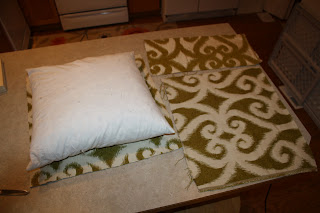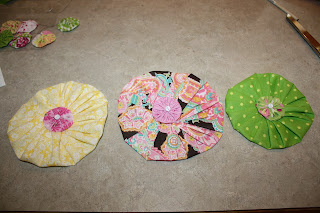Did I mention I've been redecorating my living room? Well, I am! I had a ton of pillows from the last color scheme, so instead of buying new pillows I just made slip covers for them! Talk about cheap- I got some of the fabric for 75 cents a yard! So, I thought some of you might want to freshen up your room with a few simple slip covers.
Just so you know, you DON'T have to sew these if you have a hot glue gun! Seriously, it works to just glue the fabric together!
Supplies- pillow
fabric
sewing machine or hot glue gun or iron on fabric bonding strips
(for those of you using a hot glue gun- just be sure that each seam is completely cooled and secured before you move on to the next one. )
Step one- measure the fabric- you want to allow about 1 1/2 inches around the pillow for "fluff" room. Be sure to position your fabric with the design the way you like it before you cut for the front of the pillow. Then cut two pieces of fabric for the back- you want to cut one piece about 3/4 the size of the front panel and the second piece for the back should be about 1/2 the size of the front panel. This will allow for plenty of overlap for the back section of the pillow.
Position the two pack panels next to the front panel to get an idea of overlap and the look you will have. If you are happy with it- let's move on!
Iron down the seams of the two back panels that will be overlapping for the "pocket" of the panel. First press the raw edge down about 1/4 of an inch.
Now, turn that edge over again to form a finished edge. This should also be about 1/4 inches. (if you are hot gluing or using bonding strips, you would still iron your edge first then go back and run a bead of hot glue the entire length- or place a strip of fabric bond in the seam and iron over that to melt and adhere to the fabric).
If you are sewing- turn your fabric so it is right side up and stitch a straight seam down the length of the fabric.
Once you have done both sections of the back of the cover, you are ready to fit the pieces together. Begin by laying the larger panel on top of the front cover section WITH RIGHT SIDES together- this is important- otherwise your pillow will have the back of the fabric in some spots!
Next place the smaller section on top, matching the sides and top with the fabric that will be the front of the pillow- again with RIGHT SIDES facing each other. - You should now have a layered look going with the finished seams in the middle of the back of the pillow. You can pin the sections in place to ensure you sew all the layers together. (if you are using hot glue- simply glue the larger panel to the front piece first, then the smaller one to the top of the front and the back of the larger panel so all pieces are glued together- same for heat bonding strips).
This picture just shows that I have all right sides together with the finished seams over lapping .
It should look like this from the back of the cover.
If you are sewing, just stitch a straight stitch around the entire cover, about 1/2 inch from the raw edge- making sure to keep all layers together. Once you have sewn around the cover once, it's a good idea to turn it right side out and make sure you didn't miss any fabric in the seams.
Go ahead and stitch a second straight stitch all around the edge of the cover (this is of course with the fabric turned wrong side out)- this will just give the pillow cover a little extra strength.
When you are finished you should have about a 1/4 or 1/2 inch raw edge all the way around the pillow cover.
Turn the cover right side out and stuff your pillow in there. This is how the back should look. Enough overlap that you don't see the pillow at all.
This is how the front should look- design placed nicely to the front .
Now, throw that baby in a chair or on the couch and go make about 15 more!!! Oh, is that just me?... YEAH, I DID THAT!!! I will post some pictures of all the fun pillows I made a little later.
(oh, see this cute vintage chair- it's going to be a project- I'm going to try to recover it!)

















































